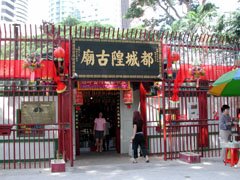 Seng Wong Beo, as is more popularly known to the older generations in Singapore, was a landmark in Tanjong Pagar. It is still a landmark, an ancient structure dwarfed by the huge and tall concrete skyscrapers. This year, 2006, it celebrates its 101st year of existence.
Seng Wong Beo, as is more popularly known to the older generations in Singapore, was a landmark in Tanjong Pagar. It is still a landmark, an ancient structure dwarfed by the huge and tall concrete skyscrapers. This year, 2006, it celebrates its 101st year of existence.Painted with both strokes of the Chinese brush style on the exposed outside wall of this temple is Du Cheng Huang Gu Miao 都城隍古庙. Cheng Huang is translated as City God in English.

This temple has an interesting history. It was founded by a Buddhist monk although the temple is more Taoist in nature. It can be considered as a syncretic temple, which is quite common in the Chinese temples in the early days of Singapore.
This temple is also well known as the temple where ghost-marriages are arranged. According to sources, sometimes, a family member of a deceased relative (single who died young) might have a dream about being requested to arrange a marriage for the deceased. Chances are it would be the mother who dreams about it. In about the same time, another family might have a similar request. This temple does "match-making" too, matching them according to the descriptions. This is but one aspects. The SPI website has a more detailed report on this.
Below is an interesting account which was posted on a signage outside the temple, explaining on the history of the temple.
Seng Wong Beo Temple

The temple was founded by Reverent Swee Oi from China. The Reverend whose family name was Huang, was educated and well versed in poetry. He was an imperial scholar during the Qing dynasty. However his keen interest in Buddhism led to his decision to become a monk. He was ordained in Fuzhou Quanzhou.
He later came to Singapore where he saw many Chinese who sailed in boats from China and settled mainly in the Tanjung Pagar and Telok Ayer areas. They worked mostly as labourers in the harbour and also as rickshaw pullers. Their life was hard. Falling ill and feeling lonely and home-sick were common. Their hardship touched Reverent Swee Oi who then decided to build a temple in Tanjung Pagar. He wanted these people to have a place where they can worship and pray for the well-being of their loved ones back home in China.
The temple was first built in the 31st year of the Qing Emperor Guang Xu's reign. Two years later, the then Chinese Consul to Singapore, Zuo Bing Long, personally wrote a tablet and presented it as a gift to the temple. The tablet still hands in the main prayer hall of the temple.
The temple worships the City God. According to Chinese beliefs, the City God guards the city from evil. Devotees come to the temple to pray for the country's peace and prosperity, for the triumph over evil and for the good health of all. The City God rewards good deeds and punishes the evil ones. He also has the responsibility to guide souls of the dead to the underworld. His temple has ben and continues to be a place of solace for its many devotees.